Matador Network's Blog, page 1109
April 30, 2019
Most beautiful palaces in Moscow

Moscow’s past is inextricably linked with the tsars and their favorite people, who, because of their status, did not live in communal flats but in incredibly fancy palaces. The palaces of St. Petersburg are world-famous, but Russia’s capital also has its fair share of magnificent noble residences, most of which are now museums. All the palaces impress with their beautiful architecture and equally beautiful interiors, as well as with their tumultuous histories. We have selected seven of them for you to add to your Moscow itinerary.
1. Tsaritsyno
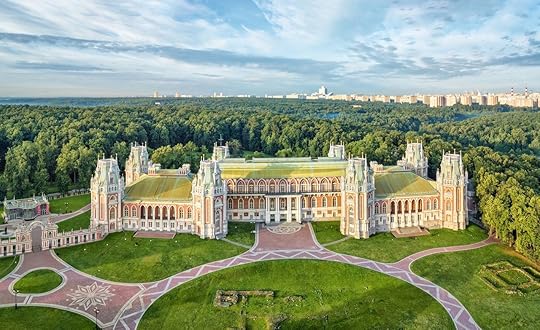
Photo: Sergey Dzyuba/Shutterstock
In 1776, Tsaritsyno was built on the order of Catherine the Great who fell in love with the pastoral beauty of the area; however, she never lived here. The empress did not like the creation of Vasily Bazhenov, so his work was torn down. A second attempt by architect Matvey Kazakov got cut short — Catherine the Great died before he could finish the 20-year enterprise. The building was abandoned until it was beautifully renovated between 2005 and 2007.

Photo: dimbar76/Shutterstock
Today, Tsaritsyno is a museum within a large, 1,000-acre park. Tsaritsyno is located south of Moscow, a 40-minute metro ride from the city center to the Tsaritsyno metro station and a 10-minute walk to get to the gate. The palace is in the middle of the park, so you’ll have to walk for another 10 minutes to access it, but the greenery, and the fountains and bridges that dot it, are a sight to see and well worth the extra footwork. The palace complex is closed on Monday, but you can access the park daily, from 6:00 AM to midnight.
2. Kolomenskoye
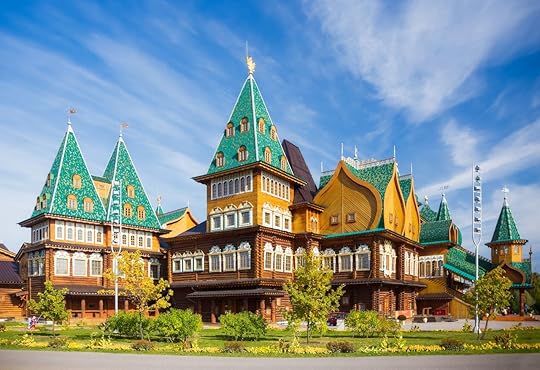
Photo: Gubin Yury/Shutterstock
As early as the 16th century, Kolomenskoye was the summer residence of the tsars. In the 17th century, Tsar Alexei Romanov built a great wooden palace on the royal estate, which was unfortunately torn down on the order of Catherine the Great in the late 18th century. The current magnificent wooden palace in Kolomenskoye was built using drawings of the one that stood on the estate so long ago.

Photo: EvgenySHCH/Shutterstock
Today, the Kolomenskoye estate is comprised of 17 architectural monuments on 990 acres, including the 16th-century Ascension Church, which is a UNESCO World Heritage site; 17th-century wooden fortresses; and a 400-year old wooden Orthodox Church. The open-air museum is opened for visitors daily, except Mondays. To get there is a 50-minute metro ride from the center of Moscow to Kolomenskaya station.
3. Petrovsky Palace

Photo: Yury Dmitrienko/Shutterstock
Built as a station on the tsars’ journeys from St. Petersburg to Moscow by order of Catherine the Great, the red and white Petrovsky Palace is the work of the famous Russian architect Matvey Kazakov (and, as such, bears a resemblance with Tsaritsyno).
Today, the palace is used as a four-star hotel, so visiting it is not an option unless as part of a rare guided tour. The edifice is also used as the House of Receptions of the Government of Moscow since 2009. To get to the Petrovsky Palace, located in the northwest of Moscow, travel on the metro to the Dinamo station and walk for fewer than 10 minutes.
4. Kuskovo

Photo: Sergey Dzyuba/Shutterstock
The huge Kuskovo complex was built between 1740 and 1780 by the wealthy and noble Sheremetev family to be used as a holiday residence. Besides the palace that was intended for receptions only, and which remains exactly the same as it was in the 18th century, the complex includes the Dutch House (a pavilion modeled on a 17th-century Dutch townhouse), Italian House (built in the style of 17th-century Italian villa), the Grotto, the Menagerie, the Hermitage and other structures in a large park with fountains, ponds, canals and a formal garden.
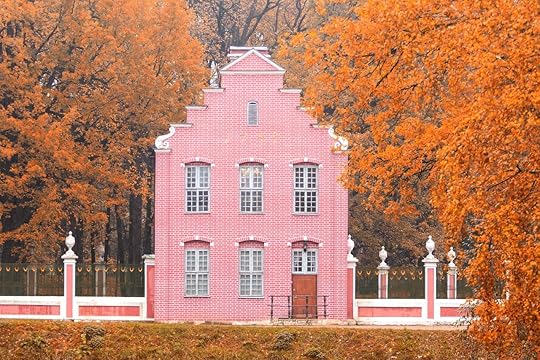
Photo: Dmitry Zimin/Shutterstock
The superb ensemble is a museum of 18th-century manor life that contains 50,000 pieces such as paintings, drawings, sculptures, and artistic furniture. The complex is also the host for the State Museum of Ceramics, where works of porcelain, glass, and ceramics are displayed. Kuskovo is a 35-minute metro ride from the city center to the Novogireevo metro station and a 15-minute walk to the complex.
5. Grand Kremlin Palace
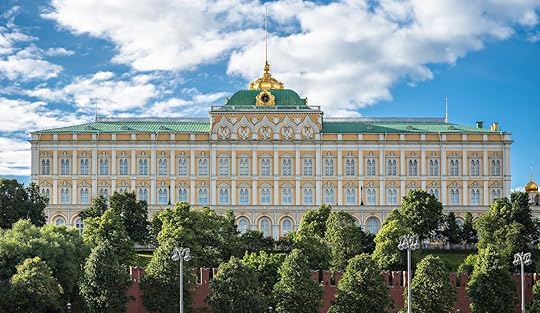
Photo: Laborant/Shutterstock
The Grand Kremlin Palace is the largest building in the Kremlin, a fortified complex of cathedrals and palaces located in the heart of the Russian capital. The Grand Kremlin Palace was built between 1837 and 1849 and used to be the tsar’s residence; nowadays, it is the residence of the President of the Russian Federation.
Although the outside may seem fancy, it is nothing compared to the lavish interior. With its intricate domed ceilings; huge, sparkling chandeliers; and gold -covered everything, it’s even fancier than Versailles. It is possible to visit the beautiful palace, but the only way to do it is by booking a two-hour tour.
6. Bykovo
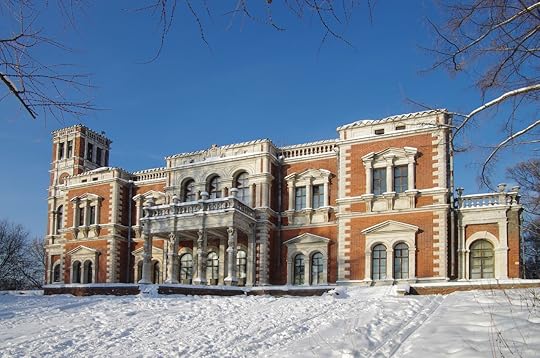
Photo: Natalia Sidorova/Shutterstock
One of the most beautiful estates in Moscow, Bykovo — also known as Marino — unfortunately sits abandoned. The complex is comprised of the incredible Church of the Vladimir Icon of the Virgin, built in 1789 and said to have been designed by famous Russian architect Vasily Bazhenov; a palatial manor rebuilt in 1856, which served as a tuberculosis sanitarium after the Bolshevik Revolution; and a rotunda by large pond, all of which sits on an overgrown, forested park.

Photo: Julia Trubarova/Shutterstock
Because the estate is neglected, it is not possible to visit the interior of the manor; however, you can walk around and enjoy the architecture from the outside. In winter, the long slope in front of the manor serves as a tobogganing spot for local kids. Unlike the rest of the estate, the church is currently being renovated. It’s a bit of a trek to get to Bykovo by public transport, but if you have a vehicle or can afford a taxi ride, it’s only a 50-minute car ride from the center of Moscow.
7. Marfino
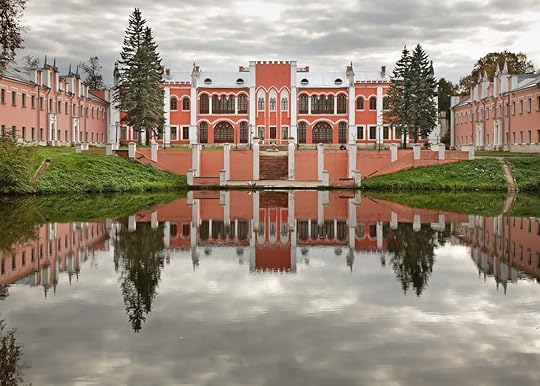
Photo: Shevchenko Andrey/Shutterstock
The Marfino estate is a unique and prime example of Gothic architecture in Moscow as it’s an ensemble where every building is of the Gothic style. After being burned down by the French in 1822, it was later rebuilt by famed architect Mikhail Bykosvky. The ensemble is comprised of a large park, large ponds, a beautiful bridge, stone gates, sculptures, the Nativity Church, a rotunda, a pavilion, and, of course, the red and white manor.
Currently, the estate hosts the sanatorium of the Ministry of Defense of the Russian Federation, so visitors need to present an ID before being granted access. The Marfino estate is located in the district of the same name, a 50-minute journey north of Moscow’s city center. 

More like this: 9 coolest places you need to hit on your trip to Moscow
The post These 7 palaces in Moscow are straight out of a fairy tale appeared first on Matador Network.

Tequila and Coke cocktail in Mexico

Tequila, Mexico, isn’t wildly popular with American tourists, especially when compared with other world-famous spirit regions like Cognac in France or Islay in Scotland. Those who do visit the village of Tequila often visit on bus tours or on the ever-popular roundtrip tequila train operated by Jose Cuervo. Yet doing so means bypassing exploring the village of Tequila itself independently, which is a shame for people looking for a true taste of the region.
Aside from large distilleries like Jose Cuervo’s La Rojena, Tequila still feels like a humble village. There aren’t any Margaritaville franchises littering the landscape. Margaritas aren’t even the signature cocktail here. The Batanga is what you should be drinking.
The Batanga sounds, at first, so unremarkable. Many say it’s just a Cuba Libre with tequila instead of rum. Those in the know swear by it, though. On a visit to Tequila Fortaleza, a distiller making tequila the original way with tahona-crushed agave, we were advised that if we did just one other thing in the village, we should try a Batanga at La Capilla, the most famous bar in town. It was further recommended to get up and stretch between rounds of Batangas. The legend goes that you don’t notice how much you’ve really drunk until you try to stand up. And you’ll want to have multiple rounds. The Batanga has made La Capilla famous the world over and earned it placement on many “best bars” lists.
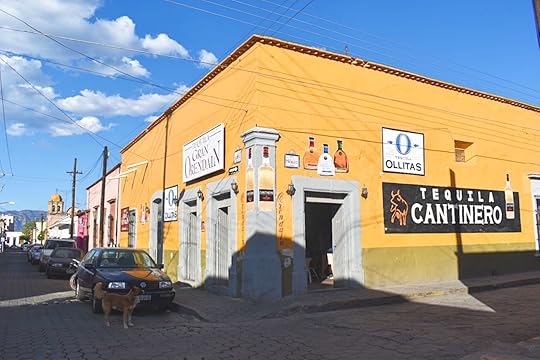
Photo: Maggie Rosenberg
A true Batanga requires some ingredients you can only find in Mexico, and some elements that you can only find at La Capilla. The Coca-Cola has to be Mexican Coke made with cane sugar rather than corn syrup. The tequila has to be the blanco from La Tequileño, which is an inexpensive mix (which means not made with 100 percent agave) that has a noticeable bite that comes through the sweet soda in a Batanga. Then there’s lime and a salt rim. Finally, there’s the not-so-secret ingredient: a quick stir with a well-worn knife.
The Batanga follows the basic principles of a good cocktail: It’s simple, and you can still taste the spirit. Sweet Coke, tart limes, salt, and slightly bitter blanco tequila all balance each other to create a spectrum of flavor. Undoubtedly, part of what’s appealing about the Batanga at La Capilla is the generous amount of tequila in the drink, which fills up about half the glass it’s served in. But then again, any respectable tequila drink should be mostly tequila.

Photo: Maggie Rosenberg
The cocktail was invented by the bar owner, Don Javier Delgado Corona, back in 1961. The Margarita was starting to gain popularity around the same time, and general tequila awareness was rising. But while anyone can make a Margarita, only one has the knife used to stir the drinks at La Capilla. Don Javier’s same knife has been used for 60 years. The knife is used not only to stir every Batanga served at the bar, but also to do some light chopping duties for the botanas (snacks) served as well. It’s believed that the residue of limes, cilantro, and jalapeños that the knife has cut over the decades has given the makeshift swizzle stick a unique seasoning.
Heeding the advice of the locals, we tested our buzz after two Batangas and decided that another one was tempting but risky. We didn’t want to drink like amateurs in such a hallowed bar. After all, La Capilla translates to “The Chapel.” We reluctantly went to fix ourselves with excellent steaks at the posh Cuervo-owned Hotel Solar de la Animas. It was the healthy decision, but not necessarily the fun one.
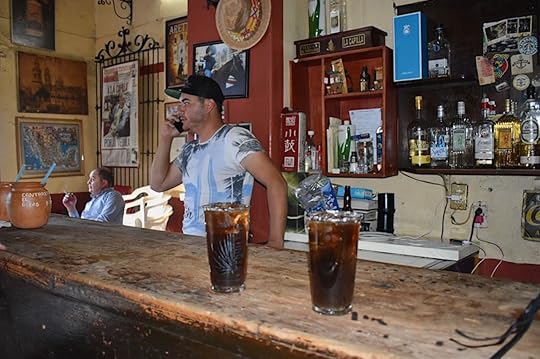
Photo: Maggie Rosenberg
La Capilla’s dusty atmosphere had more of a true cantina feel than any of the old bars that we visited in Guadalajara or Mexico City. It had the warm atmosphere and haphazard decorations of a local dive. It’s the kind of place that keeps mementos as they come, such as photos and postcards celebrating its greatest patrons. One wall was fashioned into a shrine of sorts with old soccer trophies. Keepsakes come, but not much goes. We found it hard to leave the bar ourselves.
Don Javier has stuck around, too, and is now in his 90s. He still tends the bar, and his signature drink is more popular than ever. We’ve started noticing it on cocktail menus north of the border. Unlike the Margarita, the Batanga still hasn’t become internationally famous or launched chain restaurants. This is for the best. No one else could possibly make one like they do at La Capilla, not without the knife. 

More like this: How the Margarita took over America — and lost its soul along the way
The post How the simple Tequila Coke made this Mexican bar one of the best in the world appeared first on Matador Network.

Investors pull out of Woodstock 50

Woodstock 50 — the highly anticipated festival organized to commemorate the 50th anniversary of the famous 1969 Woodstock music festival — is believed to be canceled. Originally planned to take place in Watkins Glen, New York, and featuring a wide range of artists, Woodstock 50 is now on life support after investors pulled out of the project. According to Dentsu Aegis Network’s Amplifi Life, an entity of the Japanese PR and advertising firm that has been financing the festival, “Despite our tremendous investment of time, effort and commitment, we don’t believe the production of the festival can be executed as an event worthy of the Woodstock Brand name while also ensuring the health and safety of the artists, partners and attendees.”
According to Vulture, the Woodstock 50 organizers reportedly missed several production milestones, including proper permitting, audience capacity estimates, and securing talent. The initial financial investment was made based on ticket sales estimates, but Amplifi Life grew frustrated when those numbers no longer appeared feasible. The lack of water sources, sanitation facilities, and safe entrances and exits from the area were also a concern. The festival missed its planned April 22 release for ticket sales.
Woodstock 50 organizers deny the cancellation of the event and plan to bring in new investors and move forward with the festival this coming August. 
H/T: Vulture

More like this: Every summer music festival lineup that’s been announced so far, and who you need to see
The post Woodstock 50 may be canceled as investors pull out of the project appeared first on Matador Network.

YouTuber fakes Coachella visit

This guy proved that if you can’t actually score tickets to Coachella (or don’t want to), you can still pretty easily dupe your Insta followers into thinking you went. Nineteen-year-old Byron Denton set out to teach people that social media isn’t quite what it seems by faking a weekend at Coachella. After the success of his previous prank — faking a rich lifestyle on Instagram — the London-based YouTuber “thought it would be fun to see if I could fool people again.” He told INSIDER, “With Coachella being such a big thing across social media, I thought it was the perfect chance to try and fool people a second time.”
To carry out the prank, Denton posted deceptive photos of himself pretending to be at the airport, and then wearing Coachella outfits with a photoshopped Coachella background. His first edited photo garnered over 13,000 likes at the time of its posting. Although it certainly looks like Coachella, the photo was actually taken in a park.
View this post on InstagramA post shared by byron denton (@tbhbyron) on Apr 20, 2019 at 1:57am PDT
Another photo, seemingly taken in front of Coachella’s ferris wheel, was also snapped in a park.
View this post on InstagramA post shared by byron denton (@tbhbyron) on Apr 20, 2019 at 12:46pm PDT
Eventually, Denton came clean in a YouTube video, admitting that his trip was a hoax.
Whether you fell for the prank or not, Denton hopes that people learned something from it. “You really shouldn’t compare your life and what you have to anyone else’s,” he said, “whether you think you know them or not. Especially on social media, because like I’ve demonstrated now, it is so easy to lead a fake life online.” 
H/T: Insider

More like this: Why traveling for the #gram is a terrible idea
The post 19-year-old YouTuber fakes Coachella visit to make a point appeared first on Matador Network.

April 29, 2019
Mountain biking in Andorra
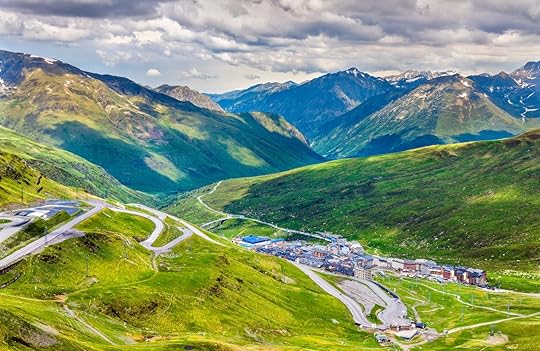
With peaks topping 11,000 feet and many of Europe’s most challenging ski resorts and backcountry terrain, the Pyrenees mountains are already top of mind for many alpine enthusiasts. For mountain bikers, the Andorra formula is a simple one: Take the varied terrain of Moab and the steeps of the nearby Alps and blend them together. Leave the crowds behind, but add in duty-free shopping and culinary chops that pull from both neighboring Spain and France. It’s an incredible combination, and you need to experience it. Here’s how to plan a mountain bike trip to Andorra this summer.
Where the heck is Andorra, and when should I come?
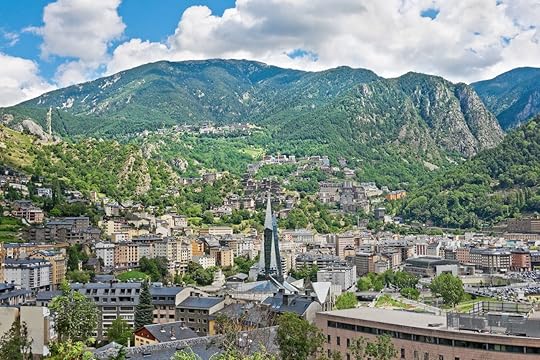
Photo: Gurgen Bakhshetyan/Shutterstock
Andorra is tiny. The entire country — actually, although it’s a sovereign state, it’s technically called a principality — is only 180 square miles. It’s no wonder it flies under the radar of most travelers to western Europe. It’s located entirely within the Pyrenees mountain range that stretches across the border between France and Spain. It’s also surrounded on all sides by protected parkland that’s been explored by few other than some locals and hardcore adventurers from nearby big cities like Barcelona and Toulouse.
The capital city of Andorra La Vella is home to 25 percent of the country’s 80,000 residents and is where nearly all of the limited urban activity in Andorra takes place. Even in the capital, the nightlife and dining scene is more akin to what you’d find in high-end mountain towns like Chamonix or Aspen than in other European capitals. While you’ll have no trouble finding a glass of fine wine or a rowdy batch of local mountaineers recounting their most recent trek over a pint, it remains the type of place where most visitors and many locals are far more concerned with getting into the mountains than they are with what’s happening in the city. Hone up your Catalan skills if you can, as it is the official language of Andorra. Spanish, Portuguese, and French are widely spoken as well.
The country’s high altitude means lots of snow falls on this tiny country each winter. As such, biking season doesn’t start until the mud begins to harden in late spring — typically May — through the Autumn months. Late spring and fall offer an escape from even the moderate crowds that Andorra sees. No matter when you visit, the terrain is pure bliss for downhill riders. Many trails even outside the established bike parks offer steep descents without a lot of uphill work needed to get to them, provided you have a shuttle.
Where to stock up on gear
If it’s doable for you to fly your bike and gear from home, do it. Having the familiarity of your own gear is a plus, especially when riding terrain that is new to you. That said, dismantling your (potentially very expensive) bike setup and entrusting it to airline personnel isn’t always a comforting thought. Your hubs for the trip will likely be centered in three towns: Andorra La Vella, San Moritz in the country’s northwest, and Soldeau in the northeast. If you need to rent or buy bikes or gear, there are plenty of strong options to do so once you’ve touched down in-country. In Andorra La Vella, your first stop after collecting bags and checking in to a hotel should be Jormabike. Here you’ll find everything you could possibly need, including bikes, gear, maps, and perhaps most importantly, advice on where to go and when. Riders Boutique offers the same in Las Massana.
Head to the ski areas.
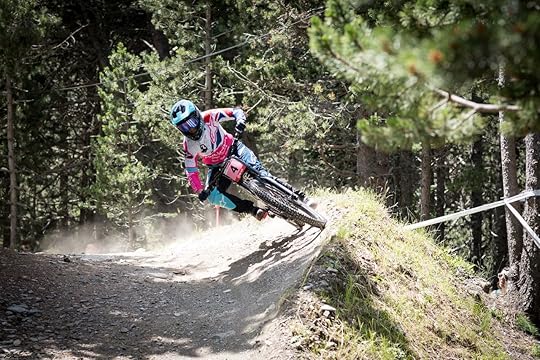
Photo: Martin Silva Cosentino/Shutterstock
As with North American ski areas, resorts here make the switch to mountain biking once the snow melts. There are two primary spots you need to hit. The first is Soldeu Bike Park in Grandvalira at the town of Soldeu in Canillo province. The park is about a 30-minute drive from the capital, so you can either stay in Soldeu or make the day-trip from Andorra La Vella. A one-day pass costs about $25 and offers access to steep but well-maintained downhill trails that are ideal for the freestyle rider. There’s a new Enduro route, a collection of features like jumps and berms, and a few trails for the more timid rider as well.
Also worth a visit is Vallnord Bike Park at the Pal-Arinsal ski area near La Massana. Vallnord is a bit easier to jump into with many intermediate and beginner trails. That said, you can get as extreme as you wish here as the tougher downhill trails attract many of Europe’s top riders each summer.
Route your backcountry trails.

Photo: anatoliy_gleb/Shutterstock
Companies like Singletrack Safari offer guided mountain bike tours that include everything up to lodging and route planning. This can be a great option for backcountry trail riding because the trail system isn’t as extensively mapped as public lands are in the United States. If you choose to route your own rides, your best bet is to base yourself in La Massana. Many backcountry trails stretch out from near Vallnord Bike Park, and a few of them actually lead you right back into town. Hit the bike park for a day or two to get your bearings while mapping out the trails you want to hit on your own, and spend afternoons after your ride identifying trailheads and end points to ensure you don’t get lost. La Massana is full of mountain bikers during the summer months and a typical night out on the town can easily land you in conversation with riders who know the area and can offer advice on where to start and finish your rides, whether or not shuttling is necessary, and what to look out for on the trail.
Apps like Trailforks have established trailheads routed out and should be used in your planning process. Beyond La Massana, the southern portion of the country offers cross country trails requiring more uphill push than the downhill around La Massana. The Engolasters trail just outside Andorra La Vella is a short and easy warmup ride before taking to the steeps up north. East of town, the Encamp-ELS Cortals 1 and 2 are popular trails near the town of Encamp. Experienced riders seeking elevation gain and a solid workout should check out the La Rabassa — Pic Negre trail south of the capital.
Where to grab a post-ride beer
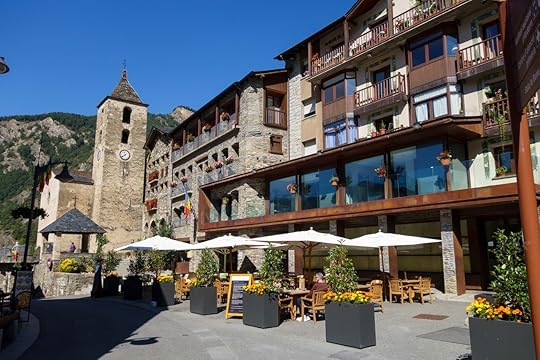
Photo: Jordi C/Shutterstock
Much like outdoors-centric cultures worldwide, Andorra has embraced the après culture with vigor. Cervesa Alpha in La Massana is a craft brew pub popular with bikers and hikers. The bar here fills up in the late afternoon with riders coming off the trail, and the crowd spills over to nearby Mon Bohemi, cheers bar, and the other pubs on streets lining Avenue de Sant Antoni and throughout the city center.
In Andorra La Vella, La Fada Ignorant is a go-to pub for a brew after a good ride, as is Paddy’s Irish Bar. For a vast selection of international brews to enjoy at your hotel, head to La Birreria. In terms of dining, Catalan cuisine dominates restaurant menus across the country, so be prepared to fuel up on esqueixada, a dish of salted cod, and escudella, a stew made of noodles, veggies, and a thick broth. They’re all about the grilled vegetables in Andorra, as well. After all your time on the trails, you’ll be ready to relax and refuel on the restaurant and bar patios. 

More like this: Mountain biking off the Skyline Gondola in New Zealand should be on your bucket list
The post How to plan a summer mountain bike trip to Andorra appeared first on Matador Network.

Rules for Japanese emperor’s wife

On Wednesday, Japan’s incoming emperor, Naruhito, will ascend to the throne a day after his 85-year-old father abdicates. And for the first time in centuries, a woman will be present to witness the enthronement, though that woman won’t be the new emperor’s wife. Satsuki Katayama, the only woman in the prime minister’s cabinet, will be in attendance to watch the ceremony, but the emperor’s wife, Masako, is not allowed to attend. Under Imperial Household Law, women in the royal family aren’t allowed to be in the room when the emperor receives the regalia representing his ascension.
Unsurprisingly, the law also holds that women aren’t allowed to reign, either. Any woman born into the royal family must officially leave it when they marry, leaving the imperial family with very few heirs. Prime Minister Abe’s government has, however, championed women’s empowerment, and pledged to discuss the role of women in the imperial family following the new emperor’s ascension. There is, however, major conservative pushback to giving women more power in the imperial family.
Hidetsugu Yagi, professor of law and philosophy at Reitaku University in Kashiwa, Japan, said, “If a female or the child of a female royal succeeds to the throne, it would be a major challenge. The imperial family would lose its legitimacy.” Despite these beliefs, the rule stating that the throne must pass through the male line of succession only dates back to the 19th century. In fact, in 125 generations of monarchs, eight women ruled as empresses when no adult men were eligible.
According to a poll conducted by The Asahi Shimbun, one of Japan’s largest daily newspapers, the public is strongly in favor of allowing a woman to rule, with over three-quarters of respondents saying they would support a female emperor.
Even the new empress herself was forced to give up a career as a successful diplomat in Japan’s Foreign Ministry, in order to become a princess. Kumiko Nemoto, professor of sociology at Kyoto University School of Foreign Studies, says, “Her presence communicates with the Japanese public her sacrifice and reluctance an ambivalence at even being there.” Although many hoped Masako would come to represent a step forward for females in the imperial family, it appears progress is already being swallowed by tradition. 
H/T: The New York Times

More like this: 12 elevated food and drink experiences to have in Japan
The post The wife of the new Japanese emperor won’t be allowed to watch his enthronement appeared first on Matador Network.

NYC to Faroe Islands flights

Iceland has soared in popularity in recent years, carving out a niche for itself as the premier “stopover destination” en route to Europe. Well, Iceland’s days of supremacy might be numbered as Atlantic Airways will begin flying nonstop from New York City to the Faroe Islands this fall. According to Simple Flying, “Atlantic Airways might do the same thing Icelandair and Wow Air did. Icelandic Icelandair and Wow Air both pioneered the stopover model… because of the two airlines, Iceland has become one of the fastest growing transatlantic markets.”
The success of those two airlines has turned Iceland into a major tourist hub, and for better or worse, the same may be on the horizon for the Faroe Islands. The airline has been slowly building its presence in the islands, introducing routes from the Faroes to Mallorca, Barcelona, Lisbon, Gran Canaria, and others. This July, they will begin flying between the Faroe Islands and Paris.
Although the New York route hasn’t been officially confirmed by the airline, in December Atlantic Airways CEO Johanna a Bergi told Local.fo that the airline had applied for permission to operate a service between Vágar and New York City. According to Bergi, “the plan is to make a couple of flights to New York City next fall — around four-six flights in all, one flight per week.”
Of course, WOW Airlines recently went out of business, so looking to the airline as a business model could be an ill-advised strategy. 
H/T: Local.fo

More like this: Why the mighty, wild Faroe Islands belong on your bucket list
The post The Faroe Islands might be the next big stopover destination appeared first on Matador Network.

Indonesia moving its capital city

In sad acknowledgement that Jakarta is sinking into the sea, Indonesia is planning to move its capital city. Relocating a capital city is a major decision not made lightly, but Jakarta is truly in dire straits. Home to over 10 million people, it’s sinking at one of the fastest rates in the world, with researchers saying that large parts of the city could be completely underwater by 2050. In the past decade, North Jakarta sunk eight feet and is continuing to sink more and more each year. Half of Jakarta is already below sea level and sits on swampy land crossed by 13 rivers, which certainly doesn’t help its situation.
Regarding the issue of relocation, three options have been discussed. The first is building an entirely new capital on another island, the second is moving the capital just outside Jakarta, and the third is designating a special zone for government offices inside Jakarta. The president is reported to favor the first option.
While no new location has been confirmed, the leading candidate is Palangkaraya in Central Borneo. The relatively subdued city, however, isn’t necessarily thrilled that it’s a leading contender for capital-hood. “I hope the city will develop and the education will become as good as in Jakarta,” one high school student told the BBC, “But all the land and forest that’s empty space now will be used. Kalimantan [the Indonesian portion of Borneo] is the lungs of the world, and I am worried, we will lose the forest we have left.”
Bambang Brodjonegoro, the country’s planning minister, said the process of moving the capital could take 10 years but remains optimistic that if other countries could do it, so can Indonesia. 
H/T: BBC

More like this: These 5 major cities are sinking rapidly into the sea
The post Indonesia is planning to move its capital because Jakarta is sinking appeared first on Matador Network.

Wyoming craft breweries/distilleries
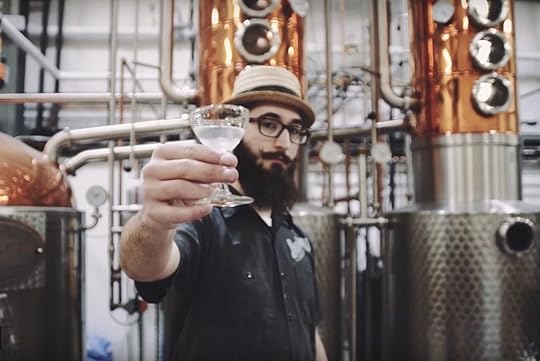
Wyoming has always loved a good drink. There are about a dozen distilleries and over 20 breweries scattered across the state today, which is laudable for most states, let alone a state where the number of cattle is double the human population. Wyoming may be the least populous state in the contiguous US (Alaska beats it otherwise), but it’s quickly becoming the nucleus of delicious drinks in the Western US. Luckily, we’re allowed to talk about it today, which wasn’t always the case.
The temperance movement of the late 19th and early 20th centuries took root in the Rockies and held on tight. Certain political and religious groups, many of the same ones vying for women’s right to vote, so vehemently opposed alcohol and saloons that all of Wyoming’s neighboring Western states went dry by 1917. During this time, Wyoming’s border towns were a hotbed of hooch activity, keeping a steady business of thirsty passersby crossing the border for a drink, or a bottle or two. The Cowboy State held out until 1919 when it finally passed a statewide law banning alcohol. National prohibition followed shortly after in 1920, but that doesn’t mean that Wyomingites simply stopped distilling.
It was as hard to enforce back then as it is to name a town in the state without a distillery or brewery today.
When the Pollock family opened Backwards Distillery in 2014, the first of its kind outside the friendly town of Casper, they didn’t know how it would be received. “There wasn’t a lot of distilling happening in their area, so we wanted to add that aspect to the community,” said co-founder Amber Pollock. “You could find good drinks in pockets, but it wasn’t the pervasive theme,” she said, which one could argue could also be said of the entire state up until very recently.

Photo: Backwards Distilling Company/Facebook
Like all successful businesses, the idea came straight from the heart. Born of a simple, shared passion for good food and drinks, Backwards Distillery was poured into existence by Amber, her brother, and her parents. They became part of a growing trend that can only be described as a food and drink renaissance. Other boutique distilleries like Jackson Hole Still Works and Wyoming Whiskey are just a few that have legs outside of their area.
“Wyoming has all the raw materials to make spirits and beer, like grain and corn, and [in this region] we have the rare ability to manufacture it. [When we thought about how there’s also an abundance of] fresh, clean water from the Rocky Mountains, that’s when we realized it wasn’t too outlandish to think about distilling our own spirits,” said Pollock.
Gruner Brothers Brewery in Casper is another business adding to the local revival. Daron Gruner was a homebrewer for 26 years before taking the plunge and opening the brewery with his brother in November 2018. The brothers use locally sourced barley from the Ralston area — they say 90 percent of the grains they use come from Wyoming — which is near Cody and Yellowstone, close to the Montana border. In just under six months of business, more than 70 bars and restaurants in the region carry the beer created in their 30-barrel brewery.
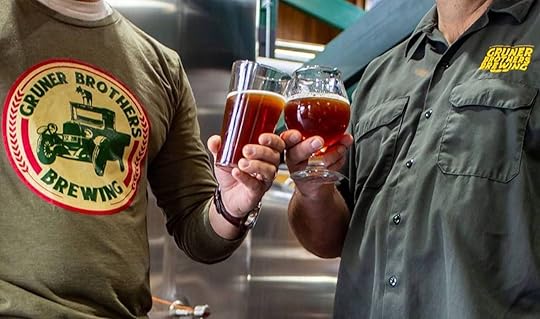
Photo: Gruner Brothers Brewing/Facebook
Gruner said that their A OK brew, or “Always Oktober,” is a bestseller. Partially inspired by the seasonal ales that are typically only served around Oktoberfest, it’s only fitting that the brothers’ most popular pour is also inspired by all the outdoor joys that Wyoming has to offer during the fall. “As brothers growing up and working in Wyoming,” the brothers said, “we know how great this state is. We appreciate the simple things in life and believe our state is unique and its beer should be too.”
You can see the commitment to Wyoming ingredients in the spirits made today at Backwards Distillery. One of the most popular, Ringleader Vodka, is made with Wyoming wheat, which is the number one dryland crop in the state.
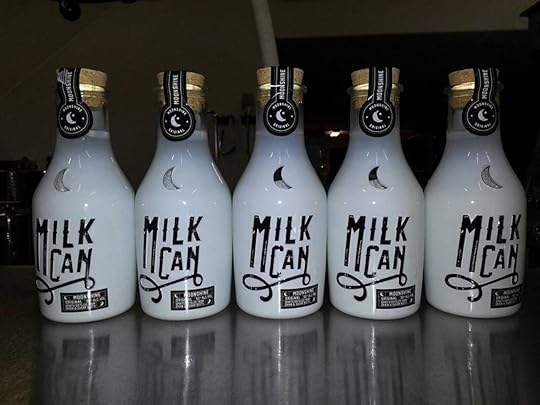
Photo: Backwards Distilling Company/Facebook
Another of Backwards’ popular spirits is Milk Can cinnamon moonshine, which tastes like baking cinnamon, which is to say, it tastes like a sweet, warm hug. It’s made of regionally sourced gains, Wyoming sugar beets, and the purest Rocky Mountain water. The decanter pays homage to Wyoming’s history of rebel distilling, back when bootleggers skirted around the law by distributing their potent concoctions in milk jugs from the back of dairy wagons.
Prohibition lasted from 1920 to 1933 across the states, and it seems throughout those years, the “Equal Rights” state could have changed its motto to “Equal Pours.” There are countless stories of police bribery and local corruption during the era, making it nearly impossible to enforce the dry law across the state.
Wyoming has always been a wild and forward-thinking territory, though it hasn’t always gotten attention for it. Now, it’s time for the rest of the country to take a look inward toward the distilling renaissance happening in the Cowboy State, where it seems the best is yet to come. 

More like this: 7 things to do in Jackson Hole, Wyoming even if you’re not Kanye West
The post The country’s least populous state is in a brewing and distilling renaissance appeared first on Matador Network.

Notre Dame greenhouse design
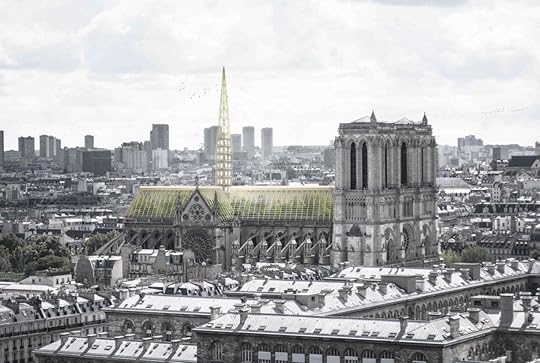
In the wake of the Notre Dame fire in Paris, discussion is now swirling around how to properly restore the damaged parts of the iconic cathedral. The roof was among Notre Dame’s most heavily devastated structural elements, and one French design studio has proposed replacing it with something resembling a greenhouse. After the roof’s destruction, the French government asked for submissions for the structure’s redesign. According to French prime minister Edouard Phillipe, the redesign should be “adapted to the techniques and challenges of our era.” Paris-based architects Studio NAB is answering the call with a design that certainly addresses social and environmental concerns.
Photos of the proposed design show an environmentally friendly apiary replacing the spire, which was destroyed in the fire. This apiary would be home to the 180,000 honey bees who live in the roof of the sacristy and survived the fire. It would also function as a place to train beekeepers and highlight the importance of bees to the environment. Studio NAB also plans to use the burnt oak framework salvaged from the church’s old attic to build planters and other facilities.
The studio envisions the greenhouse-style roof to serve as a learning center where adults and children can gather to reconnect with nature and learn about urban agriculture, horticulture, and permaculture through educational workshops.
It’s too soon to tell whether this greenhouse plan will actually go into effect, but there will certainly be many other designs proposed before one is selected. 
H/T: Lonely Planet

More like this: Dutch company proposes using 3D printing to rebuild Notre Dame
The post The Notre Dame roof might be rebuilt as a greenhouse appeared first on Matador Network.

Matador Network's Blog
- Matador Network's profile
- 6 followers



